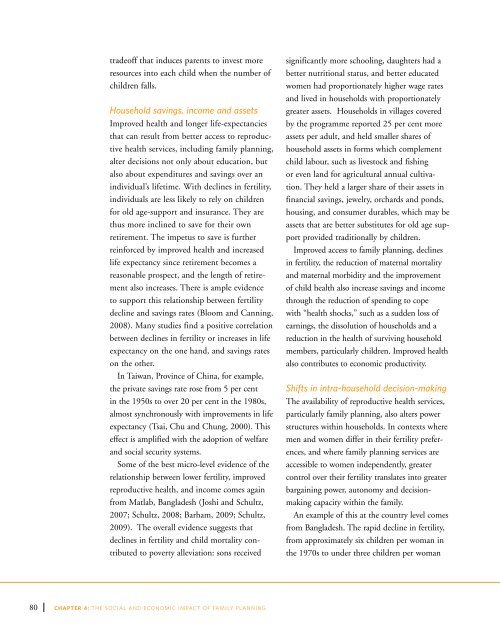State of World Population 2012 - Country Page List - UNFPA
State of World Population 2012 - Country Page List - UNFPA
State of World Population 2012 - Country Page List - UNFPA
You also want an ePaper? Increase the reach of your titles
YUMPU automatically turns print PDFs into web optimized ePapers that Google loves.
trade<strong>of</strong>f that induces parents to invest more<br />
resources into each child when the number <strong>of</strong><br />
children falls.<br />
Household savings, income and assets<br />
Improved health and longer life-expectancies<br />
that can result from better access to reproductive<br />
health services, including family planning,<br />
alter decisions not only about education, but<br />
also about expenditures and savings over an<br />
individual’s lifetime. With declines in fertility,<br />
individuals are less likely to rely on children<br />
for old age-support and insurance. They are<br />
thus more inclined to save for their own<br />
retirement. The impetus to save is further<br />
reinforced by improved health and increased<br />
life expectancy since retirement becomes a<br />
reasonable prospect, and the length <strong>of</strong> retirement<br />
also increases. There is ample evidence<br />
to support this relationship between fertility<br />
decline and savings rates (Bloom and Canning,<br />
2008). Many studies find a positive correlation<br />
between declines in fertility or increases in life<br />
expectancy on the one hand, and savings rates<br />
on the other.<br />
In Taiwan, Province <strong>of</strong> China, for example,<br />
the private savings rate rose from 5 per cent<br />
in the 1950s to over 20 per cent in the 1980s,<br />
almost synchronously with improvements in life<br />
expectancy (Tsai, Chu and Chung, 2000). This<br />
effect is amplified with the adoption <strong>of</strong> welfare<br />
and social security systems.<br />
Some <strong>of</strong> the best micro-level evidence <strong>of</strong> the<br />
relationship between lower fertility, improved<br />
reproductive health, and income comes again<br />
from Matlab, Bangladesh (Joshi and Schultz,<br />
2007; Schultz, 2008; Barham, 2009; Schultz,<br />
2009). The overall evidence suggests that<br />
declines in fertility and child mortality contributed<br />
to poverty alleviation: sons received<br />
significantly more schooling, daughters had a<br />
better nutritional status, and better educated<br />
women had proportionately higher wage rates<br />
and lived in households with proportionately<br />
greater assets. Households in villages covered<br />
by the programme reported 25 per cent more<br />
assets per adult, and held smaller shares <strong>of</strong><br />
household assets in forms which complement<br />
child labour, such as livestock and fishing<br />
or even land for agricultural annual cultivation.<br />
They held a larger share <strong>of</strong> their assets in<br />
financial savings, jewelry, orchards and ponds,<br />
housing, and consumer durables, which may be<br />
assets that are better substitutes for old age support<br />
provided traditionally by children.<br />
Improved access to family planning, declines<br />
in fertility, the reduction <strong>of</strong> maternal mortality<br />
and maternal morbidity and the improvement<br />
<strong>of</strong> child health also increase savings and income<br />
through the reduction <strong>of</strong> spending to cope<br />
with “health shocks,” such as a sudden loss <strong>of</strong><br />
earnings, the dissolution <strong>of</strong> households and a<br />
reduction in the health <strong>of</strong> surviving household<br />
members, particularly children. Improved health<br />
also contributes to economic productivity.<br />
Shifts in intra-household decision-making<br />
The availability <strong>of</strong> reproductive health services,<br />
particularly family planning, also alters power<br />
structures within households. In contexts where<br />
men and women differ in their fertility preferences,<br />
and where family planning services are<br />
accessible to women independently, greater<br />
control over their fertility translates into greater<br />
bargaining power, autonomy and decisionmaking<br />
capacity within the family.<br />
An example <strong>of</strong> this at the country level comes<br />
from Bangladesh. The rapid decline in fertility,<br />
from approximately six children per woman in<br />
the 1970s to under three children per woman<br />
80 CHAPTER 4: THE SOCIAL AND ECONOMIC IMPACT OF FAMILY PLANNING
















